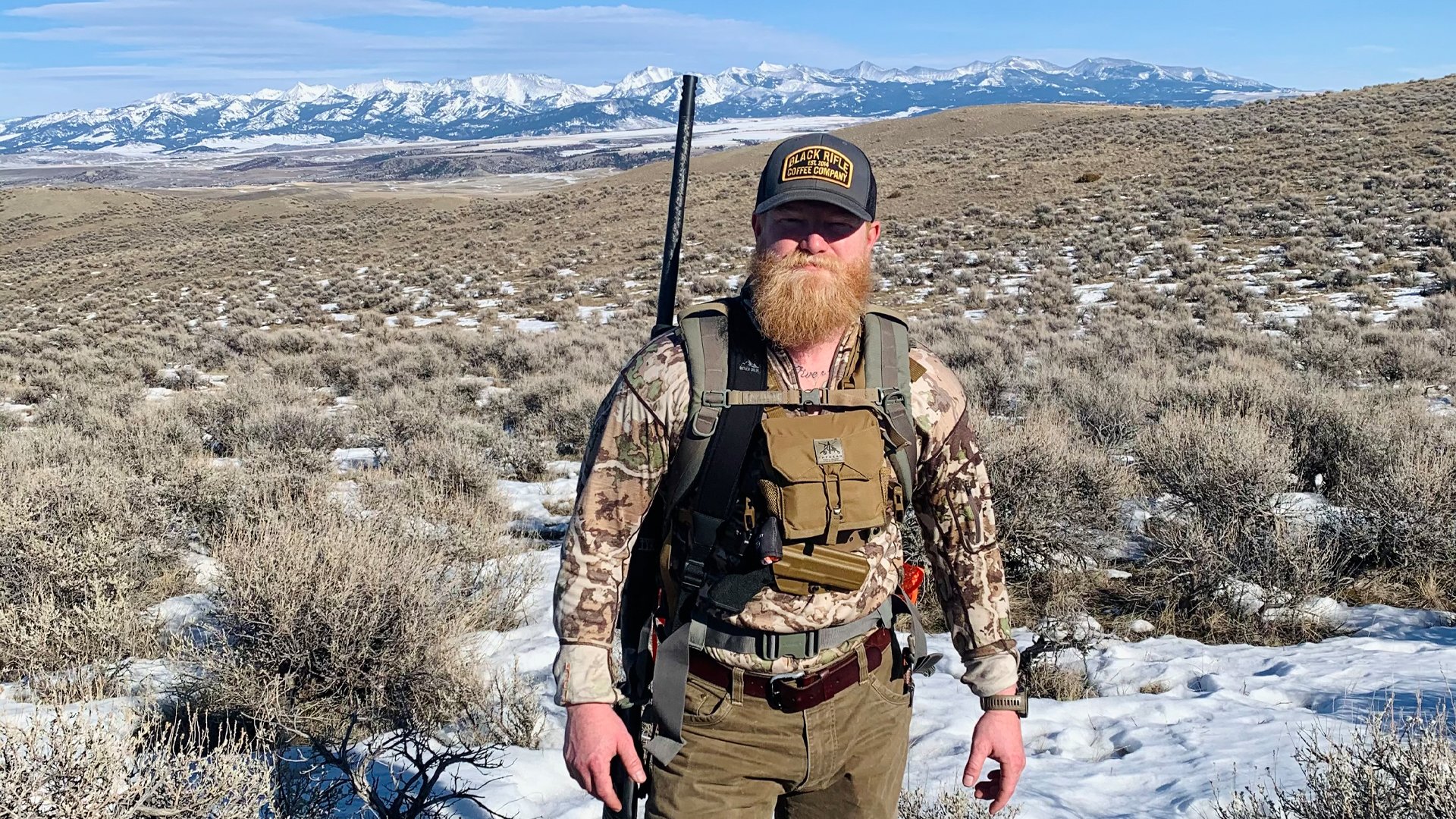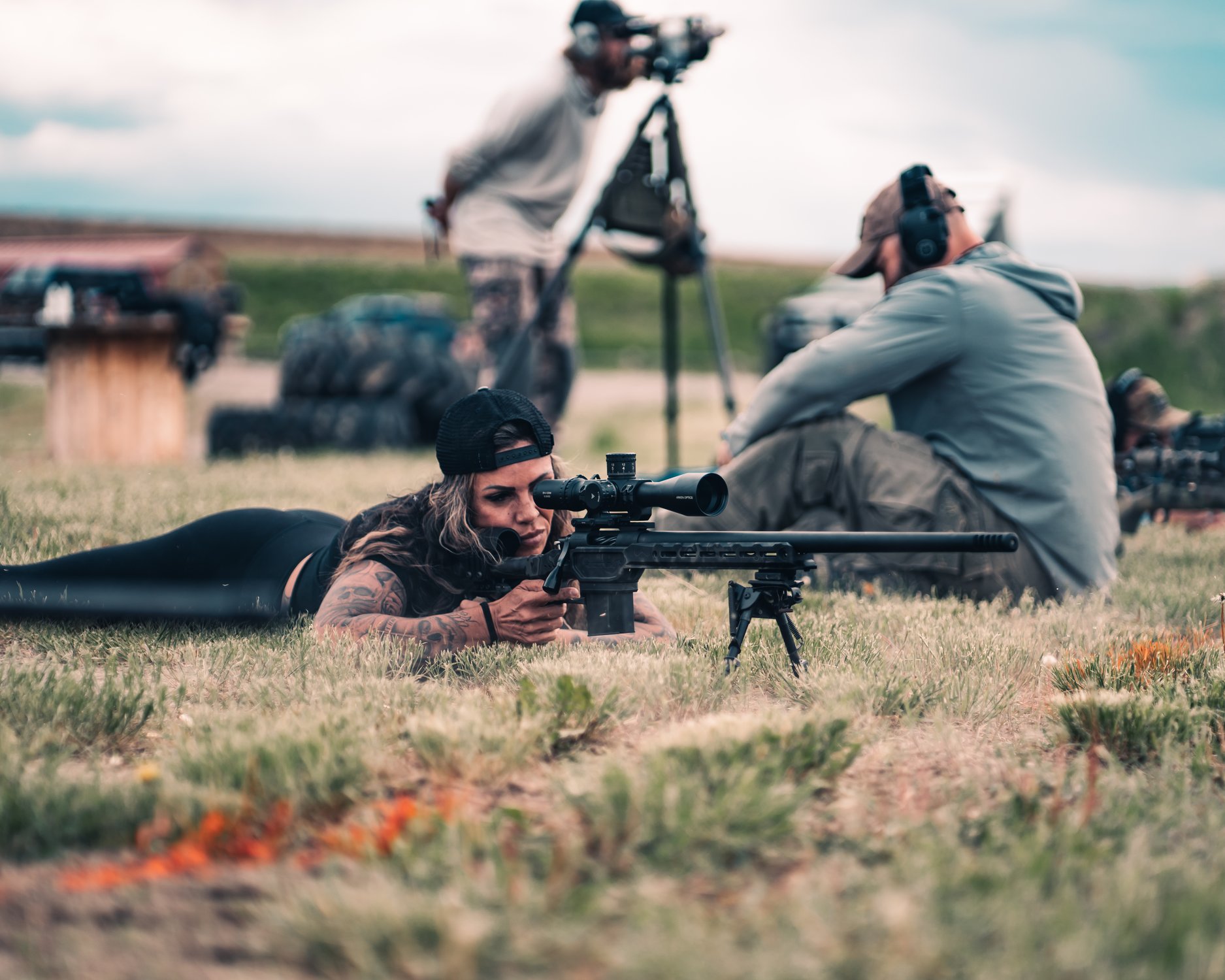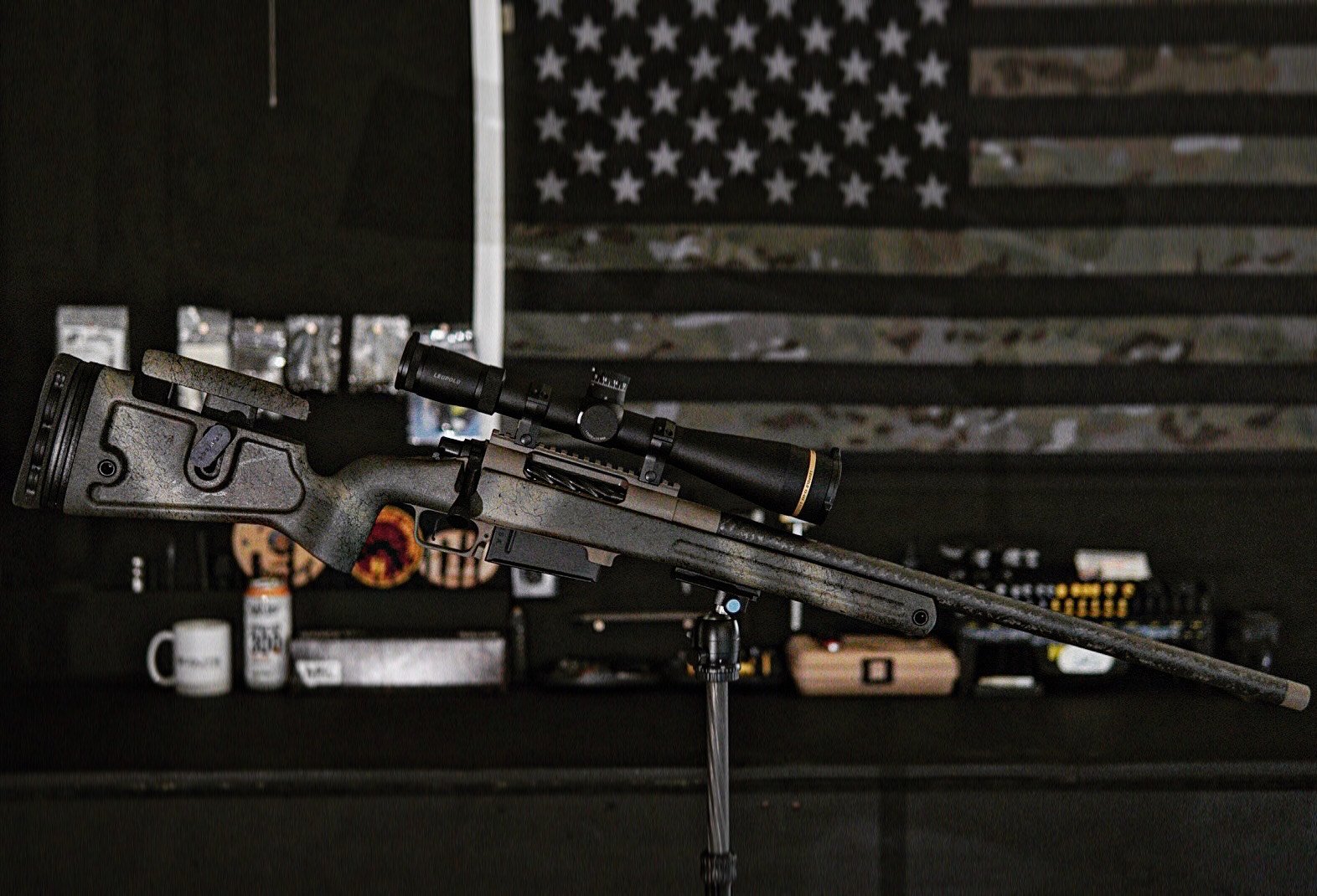A Marine Corps Veteran Finds His Calling Building Precision Rifles

Creighton Greene, owner of Scoute Arms, is an avid precision long-range hunter and instructor based in Montana. Photo courtesy of Creighton Greene.
Creighton Greene, a former Marine Corps lance corporal scout sniper with the 1st Battalion, 9th Marines, and the owner of Scoute Arms — a precision firearms manufacturer based in Montana’s Shields Valley — is on a mission to make the finest long-range rifles in the world and teach people how to use them.
Coffee or Die Magazine caught up with Greene to talk about his Georgia roots, his love for precision shooting, building sub-5-pound hunting rifles, and how women often humble special operations bros on the range.
This interview has been edited for length and clarity.

Nikki Selby sends one downrange during Scoute’s PHD course. Photo courtesy of Creighton Greene.
COD: Where did your interest in precision shooting come from?
CG: I grew up in Georgia. My dad and my grandfather were hunters. Before I got my first rifle, my dad would make me lug around this big Ithaca lever-action .22 with no ammo, just to get used to carrying a gun. I was like 5 or 6 years old, and I literally just walked behind them in the woods.
When I was old enough, we went out and found an old Sears .22 LR rifle at a garage sale. It was like 50 bucks. We tore it down. We cut the stock down on it to fit me completely, sanded everything down on the barrels and the action. We reblued the barrel, sanded the stock down, and used tung oil to redo the stock — we were surgical with that thing.
My dad put cans out at, like, 100 yards. With just iron sights, I’d smoke it. He was like, “You’re actually really good.”
So that got me into guns and the precision shooting world. I just loved the fact that I could send one piece of metal down another long, slender

Creighton Greene while in the Marine Corps. Photo courtesy of Creighton Greene.
COD: You served in the Marines as a sniper?
CG: I ran the sniper indoc and got in the sniper platoon. That was my jam. I enjoyed it. The whole fieldcraft thing, not being in a whole line platoon of angry dudes making a whole bunch of noise. I like the more clandestine side of things and working in a small team and getting to know the people that you work with very well.
I did two deployments — one to Ramadi and Fallujah, Iraq, and then the 24th MEU, or the Marine Expeditionary Unit.
COD: Did you start Scoute after you got out?
CG: I got out in 2011 and went to the Roswell, Georgia, police department and hated it. So I got out of that and worked all kinds of different jobs. I worked at a gun shop; I worked construction, dug irrigation ditches. I’ve been a train conductor. Then I came back to guns and started doing it consistently. I’ve been manufacturing firearms now for almost 10 years. Moved out here to Montana almost a year and a half ago.
“I like the more clandestine side of things and working in a small team and getting to know the people that you work with very well.”
COD: So, tell me about Scoute rifles. What’s the motivation behind your builds?
CG: I want to offer people really badass rifles that shoot like lasers, and I want them to be super lightweight, too. Our lightest rifle, our HyperLyte, is all Grade 5 titanium with a carbon fiber and composite stock, and it’s under 5 pounds. It’s, like, 4 pounds, 12 ounces, with a 20-inch barrel.
When you’ve got a sub-5-pound gun shooting a half minute of angle with factory ammunition, that’s hard to argue with. I’ve been around 1/4 MOA and under 1/4 MOA with handloads — and that’s toward the beginning of the life of the barrel.
So, you’re getting standard velocity deviations of like 7 to 8 feet per second because your barrel hasn’t finished breaking in. It’s usually 100 to 110 rounds before your barrel finally quits speeding up. You’re giving that bullet a more consistent raceway. Once it finally comes up and levels out, you’ll see standard deviations of 1 to 2 fps with handloads.
I’ve had people message me like, “Dude, this thing keeps getting tighter and tighter. Just when I think it’s leveled out, it shoots a tighter group than it did last time.”
That’s the kind of shit that keeps me rolling, man.

Photo courtesy of Creighton Greene.
COD: Guns are a very personal thing — especially custom builds. How do you handle that process with customers?
CG: Walking through the build, one of the first questions I ask the person is, “What are you going to be doing with this gun?” Like, to a T, because I’m going to build a rifle differently for somebody who’s going to be going and sitting in a box blind in Texas, looking down a long sendero, versus a guy who’s going to be covering 10 miles over a couple of days looking for elk up here at 8,500 feet.
I really want to get exactly what they’re going to be doing with the gun and get that information from them so I can really start talking about all the specifics of what they’re looking for.
COD: You build handguns as well?
CG: A lot of Glocks and Smith & Wessons, CZs, and SIGs. But I don’t just cut a design in the slide because it looks cool. It’s a purpose-driven platform. That’s one thing I preach about every gun I build — it is purpose-driven.

The first Scoute PHD (Precision Hunter Development) course participants. Photo courtesy of Creighton Greene.
Like our Obsidian — the slide weight is balanced out perfect for running a standard barrel, threaded barrel, or ported barrel. We do a certain amount of ports at a certain diameter for our shoot-flat porting, which allows the pistol to cycle 115-grain all the way up to 147-grain loads without having to change out your recoil spring.
Our Obsidian kit comes fully decked out with two barrels — one of them’s protected and crowned flush, and one is a threaded barrel. Everything’s DLC [diamond-like carbon] or PVD [physical vapor deposition] treated so it won’t rust, won’t scratch, and you won’t get holster wear on it. The triggers are absolutely magnificent — all that kind of stuff is everything I think about.
These are tools. People are going to use them for what they’re intended for. So I try to cover every little detail.
“These are tools. People are going to use them for what they’re intended for. So I try to cover every little detail.”
COD: You’ve started a precision hunter development course, or what you’re calling PHD, for long-range shooters. How’s that been received so far?
CG: We’ve just gotten insane amounts of feedback from the first one we did. We had [neurophysiologist] Kate Pate as a student in that course. I built her rifle a while back, and she wanted to learn how to use it effectively. She and Nikki [Selby], another friend of mine, were sharing all kinds of posts and pictures, and they had friends reaching out looking to do this course. So, I was like, “You know what? Let’s do an all-women precision hunter development course.”
We’ve got a facility out here where we can get out to 2,200 yards. Nikki hit a mile with a 6 Creedmoor. They were the only two women in my last course, and they took first and second place in the skills competition.
You could see it got to some egos on the range. There were former military guys out there, you know, 24 years in Special Forces. It was just so awesome to see. Everybody had a really good time and learned a lot.

Nikki Selby sends one downrange during Scoute’s PHD course. Photo courtesy of Creighton Greene.
There’s a reason I’m putting this on. I might build the most lightweight, accurate hunting rifles in the world, but I don’t condone just taking these rifles out and thinking that you can shoot an elk at 1,000 yards ethically. There’s too much of that going on now, and animals are getting wounded and running on other people’s properties, and the meat’s going bad, and you gotta get the green jeans, or game wardens, involved.
All that shit can be completely avoided. I want people to hone their craft. I want people to look at this from a completely different angle and to know their limitations, to know their limits in terms of what they can actually do effectively.
That’s the main feedback I got, was just how much everybody learned. That’s why I want to continue to do this.
<hr>
This article first appeared in the Fall 2022 edition of Coffee or Die’s print magazine as "For the Love of Long Range."
Read Next: US Army Sniper vs. US Marine Scout Sniper — Who’s the Sharpest Shooter?

Matt Smythe is a former staff writer for Free Range American. He hails from the Finger Lakes region of western New York. An Army veteran and lifelong outdoorsman, Matt suffers from an inability to sit still. If he’s not in the woods, on the water, or busy with some sort of renovation project, he’s likely elbows-deep in restoring his ’67 Bronco. His work has appeared in Gray’s Sporting Journal, the Fly Fish Journal, The Drake, Southern Culture on the Fly, Revive, Midcurrent, Trout, and a handful of other non-outdoors-related magazines and literary journals.
BRCC and Bad Moon Print Press team up for an exclusive, limited-edition T-shirt design!
BRCC partners with Team Room Design for an exclusive T-shirt release!
Thirty Seconds Out has partnered with BRCC for an exclusive shirt design invoking the God of Winter.
Lucas O'Hara of Grizzly Forge has teamed up with BRCC for a badass, exclusive Shirt Club T-shirt design featuring his most popular knife and tiomahawk.
Coffee or Die sits down with one of the graphic designers behind Black Rifle Coffee's signature look and vibe.
Biden will award the Medal of Honor to a Vietnam War Army helicopter pilot who risked his life to save a reconnaissance team from almost certain death.
Ever wonder how much Jack Mandaville would f*ck sh*t up if he went back in time? The American Revolution didn't even see him coming.
A nearly 200-year-old West Point time capsule that at first appeared to yield little more than dust contains hidden treasure, the US Military Academy said.












